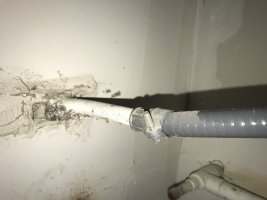-
Welcome to The Building Code Forum
Your premier resource for building code knowledge.
This forum remains free to the public thanks to the generous support of our Sawhorse Members and Corporate Sponsors. Their contributions help keep this community thriving and accessible.
Want enhanced access to expert discussions and exclusive features? Learn more about the benefits here.
Ready to upgrade? Log in and upgrade now.
You are using an out of date browser. It may not display this or other websites correctly.
You should upgrade or use an alternative browser.
You should upgrade or use an alternative browser.
Name that violation. Electrical
- Thread starter jar546
- Start date
steveray
SAWHORSE
Guessing that is the wrong connector for that application....
Maybe...
E3403.3 Listing and labeling. Electrical materials, components,
devices, fixtures and equipment shall be listed for the
application, shall bear the label of an approved agency and
shall be installed, and used, or both, in accordance with any
instructions included in the listing and labeling. [110.3(B)]
Maybe...
E3403.3 Listing and labeling. Electrical materials, components,
devices, fixtures and equipment shall be listed for the
application, shall bear the label of an approved agency and
shall be installed, and used, or both, in accordance with any
instructions included in the listing and labeling. [110.3(B)]
This is indoors ....right?
mark handler
SAWHORSE
Fitting yes.
Any splicing of wires?
Any splicing of wires?
jar546
CBO
This is indoors ....right?
Yes but not relevant
jar546
CBO
The violation is what you can see, not what you can'tFitting yes.
Any splicing of wires?
I believe that the coupling in the OP is for FMC. For LFNC, this would be the appropriate coupling to use.

https://www.graybar.com/store/en/gb/zinc-plated-steel-flex-to-emt-combination-coupling

https://www.graybar.com/store/en/gb/zinc-plated-steel-flex-to-emt-combination-coupling
Last edited:
Not an electrical inspector (WA State L&I is AHJ), but looks to me that the clamp has been tightened all the way down and has not clamped onto the LFNC.
The clamp, if I had to speculate, is not for use with LFNC.
I noticed the maxed out clamp too....now that would be worth a correction. If the conduit had been wrapped with tape until it was large enough to work with the clamp I doubt that I would write a correction....
Last edited:
As I don't typically look at electrical, I'd like to get your experienced insight... isn't the coupling in the original picture for EMT to FMC? LFNC couplings are typically a compression bushing I believe.I noticed the maxed out clamp too....now that would be worth a correction. If the conduit had been wrapped with tape until it was large enough to work with the clamp I doubt that I would write a correction....
You are correct. The location would not require liquid tight conduit and the fitting worked except for being loose.....As I don't typically look at electrical, I'd like to get your experienced insight... isn't the coupling in the original picture for EMT to FMC? LFNC couplings are typically a compression bushing I believe.
Mr. Inspector
SAWHORSE
Can't tell if LFMC is supported within 12" of conduit termination. NEC 350.3
jar546
CBO
I believe that the coupling in the OP is for FMC. For LFNC, this would be the appropriate coupling to use.

https://www.graybar.com/store/en/gb/zinc-plated-steel-flex-to-emt-combination-coupling
As long as it is EMT to LFNC which is what was used, not LFMC

